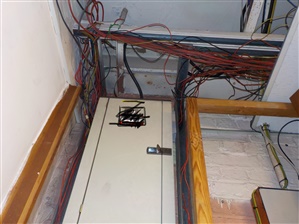Colin Haggett:Zoomup:Colin Haggett:Zoomup:
I agree that the removal of only sufficient outer sheath in order to be able to identify the tails is best, but I fail to see a problem with removing more inside the CU: it does reduce the bulk.Hear, hear, well said Chris. Also the modern carp tough copper meter tails are difficult to bend easily. Whatever happened to the nice easily bendable stuff? I normally do the sharp bends and then afterwards cut the strands all off square with my BIG cutters, as they come out of alignment after bending. Don't yer ands ert after manhandling modern tails?
Z.
25mm flexible tails are widely available coloured brown and blue.
Many wholesalers just give us the tough difficult to bend stuff. I have even seen a meter installer complaining about the tough rigid stuff he has to use as well. Perhaps its the cheapest, in more ways than one. Which type are you referring to please?
Z.I use Flexi Meter Tail Pack 25mm 6181Y Brown & Blue (19 Strands) 16mm 6491X Green Yellow. Just ask for a flexi tail pack miles better to use. Getting expensive now with copper prices going up every week.
Thanks Colin, that sounds like a good solution.
Z.
Unsheathed cables touch metalwork all the time inside trunking or conduit.

Colin Haggett:
Am still C2, you’ve got basic insulation passing through a hole in a metal consumer unit without a grommet. It’s potentially dangerous, it might be a remote danger but it’s there and needs improvement. You have two layers of protection missing, the next is a big bang and a flash.
Is the tail touching the metal, pressing on it perhaps, or is it centrally positioned in free air?
Z.
Sparkingchip:
“The problem is caused by poor management of meter installers, they do not have Henly Blocks available and are not supposed to open CUs. How is the problem of short tails resolved?”
Easy, fit an isolation switch between the consumer unit and meter, replacing the tails between the isolation switch and meter if required.
But that makes too much sense.
What? Free of charge?!!!
davezawadi (David Stone):
You are doing it now Chris.
Tails identified with the old colours are not a C3 by any reasonable test. There should be a label saying that mixed colours may be present, quite why that is needed is also dubious now, although when the change took place perhaps necessary. There is no need whatsoever to improve the wire colour codes. A black/red cable from a switch drop should have a red or brown sleeve on the switched live (black) but this may be given a C3, it is somewhat inconvenient when a ceiling rose is replaced. C2 is not somewhere between a C1 and C3 either, it is for potentially dangerous as you know very well, which the examples above are not, at least in the normal sense of danger. C3 is for regulation non-compliances which are not dangerous if you like that definition. A plastic CU in a domestic is not dangerous, it is potential loose screws which may be, so we code it as a C3. The inspector should check the screws and is then sure this problem is not present in the CU, thus C3. A plastic CU is perfectly permissible in other premises, so this requirement is somewhat anomalous, however, we seem to have it.
Well, C3 if there is no colours notice. I must say that Daughter was somewhat alarmed when I slapped a "WARNING" notice on her CU. ?
Notice or not, there is no need to replace the tails (or other cables) - just put those coloured (+/- lettered) cable ties around them. Not too difficult to rectify the grommet and sheath either.
I fully agree that a plastic CU (at home) is only C3 (the power to this tablet arrives via one) but what of those loose screws? In testing them, do we not tighten them? Or having found them loose, do we return them to the condition in which we found them? Yes, that's a bit absurd!
We're about to take you to the IET registration website. Don't worry though, you'll be sent straight back to the community after completing the registration.
Continue to the IET registration site